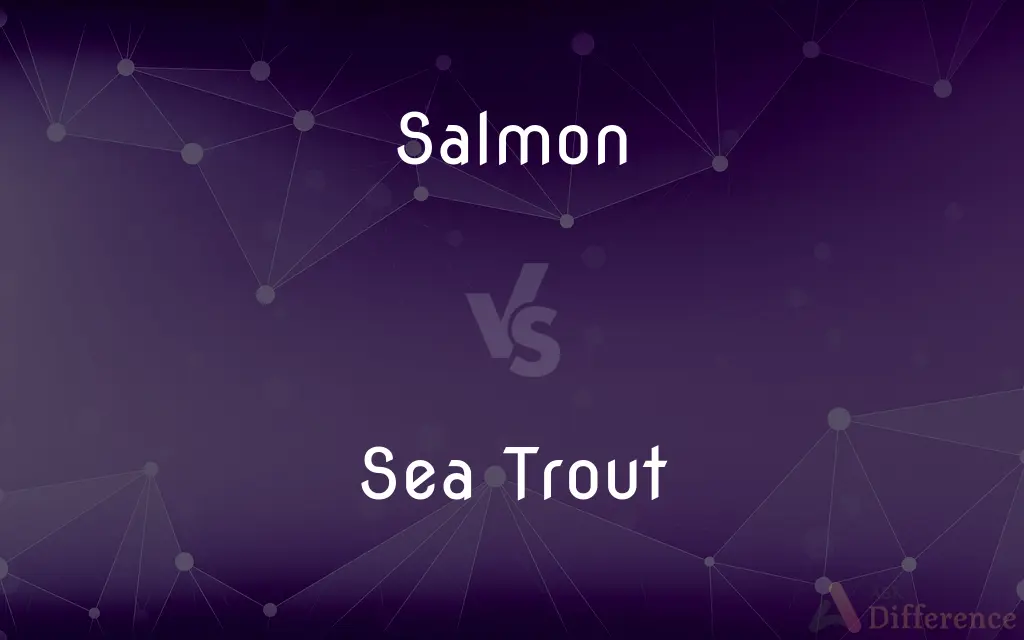Salmon vs. Sea Trout — What's the Difference?
By Urooj Arif & Maham Liaqat — Published on March 17, 2024
Salmon is a popular fish known for its pink flesh and rich flavor, while Sea Trout, resembling salmon, offers a milder taste and lighter color.

Difference Between Salmon and Sea Trout
Table of Contents
ADVERTISEMENT
Key Differences
Salmon is recognized for its distinct pink to orange flesh, rich in flavor and oily texture, primarily due to its high fat content, especially omega-3 fatty acids. These characteristics make salmon a favorite in various cuisines, celebrated for both its taste and nutritional benefits. On the other hand, Sea Trout, often mistaken for salmon due to its similar appearance, typically has a paler, more delicate flesh. The flavor of Sea Trout is generally milder than salmon, which can make it more versatile in dishes that require a subtler fish taste.
Habitat and lifecycle differences are notable between the two species. Salmon are anadromous, migrating from their oceanic feeding grounds to freshwater rivers to spawn, a journey that significantly influences their muscle structure and fat distribution, contributing to their distinct flavor and texture. In contrast, Sea Trout, while also anadromous in some populations, can spend their entire lifecycle in freshwater or coastal areas, leading to variations in their flesh's texture and flavor based on their specific habitat and diet.
Salmon species, such as Atlantic and Pacific salmon, are widely farmed, making them more readily available in markets year-round. This farming has implications for both the environmental impact and the nutritional content of the fish, including differences in fat content and possible exposure to antibiotics or other farming chemicals. Conversely, Sea Trout, particularly those caught in the wild, are less commonly farmed and might be subject to more stringent fishing regulations to preserve natural populations, affecting their availability and seasonality.
The culinary applications of salmon and Sea Trout also differ. Salmon's robust flavor and fatty texture make it suitable for various cooking methods, including grilling, baking, and smoking, and it is a staple in dishes such as sushi and sashimi. Sea Trout, with its milder flavor and finer texture, may be preferred in more delicately flavored dishes, where the fish's subtler taste can be appreciated without overwhelming other ingredients.
The nutritional profiles of salmon and Sea Trout offer distinct benefits. Salmon is highly regarded for its omega-3 fatty acid content, contributing to cardiovascular health, brain function, and inflammation reduction. Sea Trout also provides a good omega-3 fatty acids source but may have a lower overall fat content, making it a lighter option for those seeking the health benefits of fish with fewer calories.
ADVERTISEMENT
Comparison Chart
Color
Pink to orange flesh
Paler flesh, often more delicate
Flavor
Rich and oily, pronounced flavor
Milder, more subtle flavor
Habitat
Anadromous, migrating from ocean to freshwater to spawn
Some populations are anadromous, but many remain in freshwater or coastal areas
Availability
Widely available, commonly farmed
Less commonly farmed, more seasonal
Culinary Uses
Versatile in cooking, used in sushi, grilling, smoking
Preferred in delicate dishes, valued for its subtler taste
Nutritional Content
High in omega-3 fatty acids, beneficial fats
Good source of omega-3, generally lower in fat
Compare with Definitions
Salmon
Widely available due to farming.
Farmed salmon ensures year-round availability in supermarkets.
Sea Trout
A lighter option with good nutritional value.
Sea Trout was part of her balanced, health-conscious diet.
Salmon
Rich in flavor, making it a favorite for many.
The rich flavor of salmon makes it perfect for hearty meals.
Sea Trout
Less commonly farmed, more seasonal.
She looks forward to Sea Trout season for its fresh catch.
Salmon
Known for its pink flesh and high omega-3 content.
She chose salmon for its health benefits and rich flavor.
Sea Trout
Preferred in delicately flavored dishes.
He used Sea Trout in a subtle, herb-infused recipe.
Salmon
Popular in various cuisines around the world.
Grilled salmon is a staple in his weekly dinner menu.
Sea Trout
Offers a milder taste compared to salmon.
Sea Trout was her choice for a light, summery dish.
Salmon
Suitable for a range of cooking methods.
He loves to prepare smoked salmon for special occasions.
Sea Trout
Can be found in freshwater and coastal habitats.
Catching Sea Trout in the local river was his favorite pastime.
Salmon
Any of various large salmonid food and game fishes of the genera Oncorhynchus and Salmo of northern waters, having pink or red flesh and characteristically swimming from salt to fresh water to spawn.
Salmon
The flesh of a salmon, used as food.
Salmon
A yellowish pink to light or reddish orange.
Salmon
One of several species of fish, typically of the Salmoninae subfamily, brownish above with silvery sides and delicate pinkish-orange flesh; they ascend rivers to spawn.
Grilled salmon
Salmon paté
Salmon steak
Salmon
A meal or dish made from this fish.
Salmon
A pale pinkish-orange colour, the colour of cooked salmon.
Salmon
The upper bricks in a kiln which receive the least heat.
Salmon
(Cockney rhyming slang) snout (tobacco; from salmon and trout)
Salmon
Having a pale pinkish-orange colour.
Salmon
To ride a bicycle the wrong way down a one-way street.
Salmon
Any one of several species of fishes of the genus Salmo and allied genera. The common salmon (Salmo salar) of Northern Europe and Eastern North America, and the California salmon, or quinnat, are the most important species. They are extensively preserved for food. See Quinnat.
Salmon
A reddish yellow or orange color, like the flesh of the salmon.
Salmon
Of a reddish yellow or orange color, like that of the flesh of the salmon.
Salmon
Any of various large food and game fishes of northern waters; usually migrate from salt to fresh water to spawn
Salmon
A tributary of the Snake River in Idaho
Salmon
Flesh of any of various marine or freshwater fish of the family Salmonidae
Common Curiosities
What are the nutritional benefits of salmon and Sea Trout?
Both are good omega-3 fatty acid sources, with salmon typically higher in beneficial fats, and Sea Trout offering a lighter option with good nutritional value.
How do the culinary uses of salmon and Sea Trout differ?
Salmon's robust flavor suits a variety of cooking methods, while Sea Trout's milder taste is preferred in delicate dishes.
What distinguishes salmon from Sea Trout in terms of flavor?
Salmon is known for its rich and oily flavor, while Sea Trout has a milder, more subtle taste.
Is there a significant difference in fat content between salmon and Sea Trout?
Salmon typically has a higher fat content, especially omega-3 fatty acids, contributing to its richer flavor, while Sea Trout may have a lower overall fat content.
How does the habitat of salmon compare to that of Sea Trout?
Salmon are anadromous, migrating from ocean to freshwater to spawn, whereas Sea Trout can be anadromous or remain in freshwater/coastal areas.
How does the color of salmon and Sea Trout flesh compare?
Salmon flesh ranges from pink to orange, while Sea Trout flesh is generally paler and more delicate.
Are salmon and Sea Trout available year-round?
Salmon, especially farmed varieties, are widely available year-round, while Sea Trout, being less commonly farmed, may be more seasonal.
Can Sea Trout be farmed like salmon?
Sea Trout is less commonly farmed than salmon, which affects its availability and seasonality.
What impact does habitat have on the flavor of these fish?
The habitat and lifecycle (e.g., anadromous migration for salmon) significantly influence the muscle structure, fat distribution, and consequently, the flavor and texture of the fish.
How do fishing regulations affect the availability of Sea Trout compared to salmon?
Sea Trout fishing, especially in the wild, may be subject to more stringent regulations to preserve natural populations, which can limit availability compared to more widely farmed salmon.
Share Your Discovery

Previous Comparison
Infrared Cookers vs. Induction Cookers
Next Comparison
MMS vs. SMSAuthor Spotlight
Written by
Urooj ArifUrooj is a skilled content writer at Ask Difference, known for her exceptional ability to simplify complex topics into engaging and informative content. With a passion for research and a flair for clear, concise writing, she consistently delivers articles that resonate with our diverse audience.
Co-written by
Maham Liaqat













































